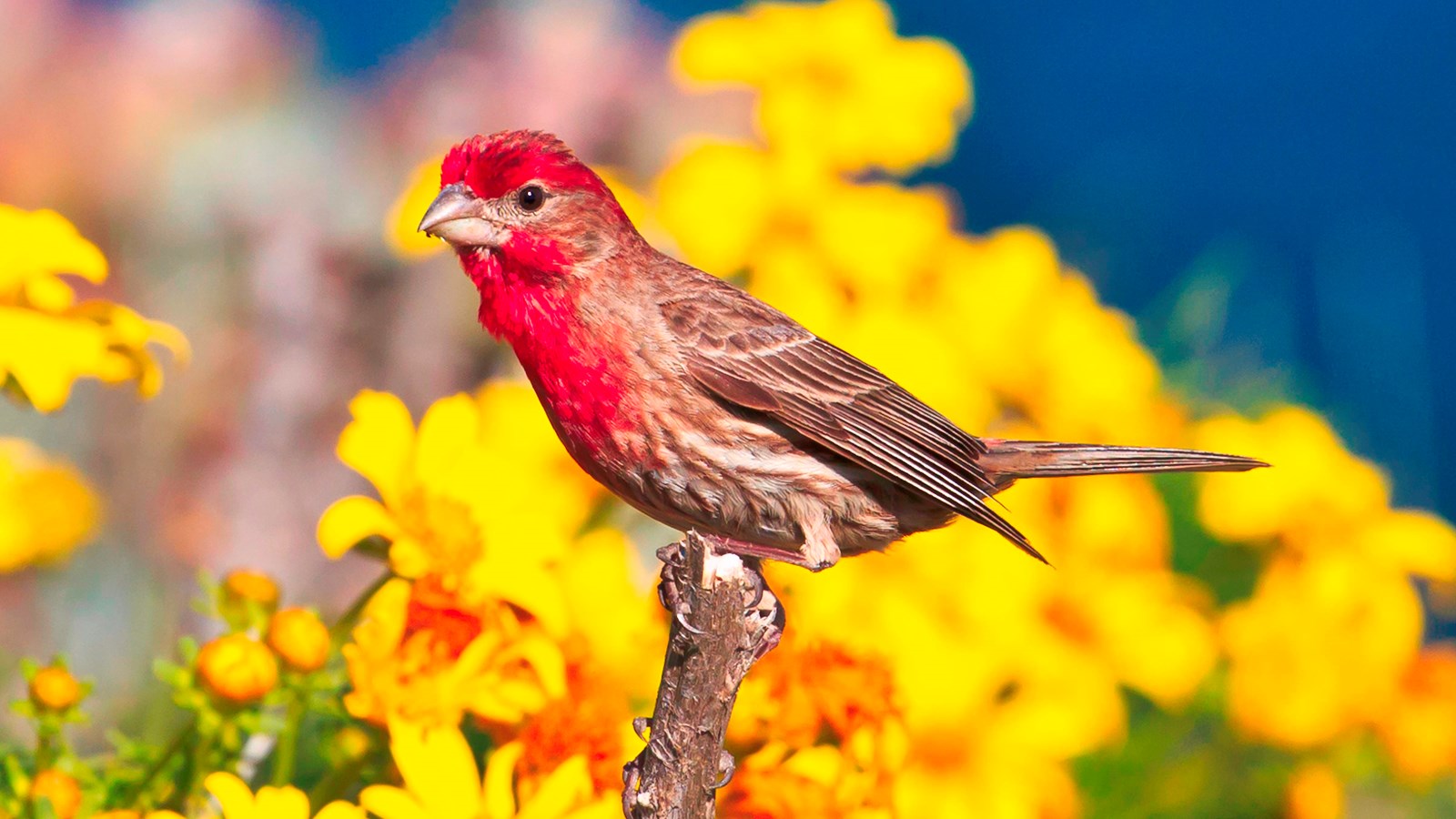Last updated: May 21, 2021
Place
House Finch

Tim Hauf, timhaufphotography.com
Scientific Name
Carpodacus mexicanus frontalis
Introduction
The endemic subspecies of house finch, m. frontalis, is found only on Santa Barbara Island and the other southern Channel Islands. The northern islands all have the same subspecies as the coastal mainland does, so they are not endemic. The distinguishing characteristic of this sub species is a heavier bill and some evidence of vocalization differences. The degree of red color in house finches is somewhat dependent on diet. House finches on the southern islands can frequently be found nesting on the cactus. This bird is primarily a ground feeder and particularly favors seeds from composites.
Quick and Cool Facts
- The house finch was originally a bird of the western United States and Mexico. In 1940 a small number of finches were turned loose on Long Island, New York, after failed attempts to sell them as cage birds ("Hollywood finches"). They quickly started breeding and spread across almost all of the eastern United States and southern Canada within the next 50 years.
- The total house finch population across North America is staggering. Scientists estimate between 267 million and 1.4 billion individuals.
- House finches feed their nestlings exclusively plant foods, a fairly rare occurrence in the bird world. Many birds that are vegetarians as adults still find animal foods to keep their fast-growing young supplied with protein.
- The oldest known house finch lived to be 11 years, 7 months old.
- The red of a male house finch comes from pigments contained in its food during molt (birds can't make bright red or yellow colors directly). So the more pigment in the food, the redder the male. This is why people sometimes see orange or yellowish male house finch.
- Females prefer to mate with the reddest male they can find, perhaps increasing the probability of obtaining a capable mate who can do his part in feeding the nestlings.
Appearance
The adult male of the species typically has a bright red breast, rump, forehead, and supercilium;center of crown, nape, and back are brown and dark wing has two white wing bars and pale edges to flight feathers. Belly and rest of underparts are mostly white, with clear demarcation from red breast, and bold streaks on flanks. Some birds have an orange tone to breast. Contrastingly, the adult female has gray-brown plumage, streaked above and below, with two pale wing bars and pale edges to flight feathers. Juveniles will show the same appearance as the adult female. The distinguishing characteristics of the subspecies found in Santa Barbara Island is a heavier bill and some evidence of vocalization differences.
Range
House finches are very adaptable and can be found in a wide range of habitats, from arid deserts to open woodlands and shrubby fields. They are common in both urban and suburban areas as well, extending from the southern edge of Canada through central and southern Mexico. Populations are less dense in the central Great Plains states and the southeastern United States. The endemic subspecies of house finch, m. frontalis, is found only on Santa Barbara Island and the other southern Channel Islands. The northern islands all have the same subspecies as the coastal mainland does, so they are not endemic. These birds generally do not migrate, but they can become nomadic in search of food. In the park, house finches declined on San Miguel from 1993 to 2003, for unknown reasons, and have increased in recent years.
Habitat
House finches are native to open and desert habitats, but have expanded their range, naturally and through introductions, and now can be found in almost any kind of human-altered habitat. They prefer edge habitat and are absent from dense coniferous forests.
Feeding
The vast majority of the house finch's diet is vegetable matter--seeds, buds, berries, and nectar. They feed their young regurgitated seeds. They eat a few small insects, especially aphids, but are primarily seed- and fruit-eaters at all times of the year.
Reproduction
House finches are monogamous, and pairs tend to form while the birds are in their winter flocks. Some pairs may stay together year round. They choose a wide variety of nesting sites, and will nest in man-made objects such as window ledges and holes in buildings. Ivy growing on buildings or trees creates many nesting sites. Nests may also be located in conifer trees, hanging planters, and old nests of other birds. The first requirement is a solid base with some overhanging material. The female builds most of the nest, which is an open cup of grass, weeds, twigs, leaves, and rootlets, lined with feathers and other fine material. The female incubates 4 to 5 eggs for 13 to 14 days while the male brings her food. The female broods the young for the first few days after they hatch, and the male continues to bring food. The female then joins the male in bringing food to the young. The young leave the nest after 12 to 15 days and may be fed by the male for about two more weeks, while the female starts a second clutch. Pairs may raise three or more broods each season.
Conservation Status
The house finch has an extremely large range and appears to be increasing, and so does not approach the thresholds for Vulnerable under any of the criteria of the IUCN Red List. It is instead identified as a species of Least Concern.
Additional Information
- http://www.allaboutbirds.org/guide/house_finch/lifehistory
- http://enature.com/fieldguides/detail.asp?recnum=BD0050
- http://www.birdweb.org/birdweb/bird/house_finch
- http://birding.about.com/od/birdprofiles/p/housefinch.htm
- http://www.iucnredlist.org/details/106008856/0
- Coonan, T.J., R.C. Klinger and L.C. Dye. 2011. Trends in landbird abundance at Channel Islands National Park, 1993-2009. Natural Resource Technical Report NPS/CHIS/NRTR-2011/507. National Park Service, Fort Collins, Colorado. 86 pp.
